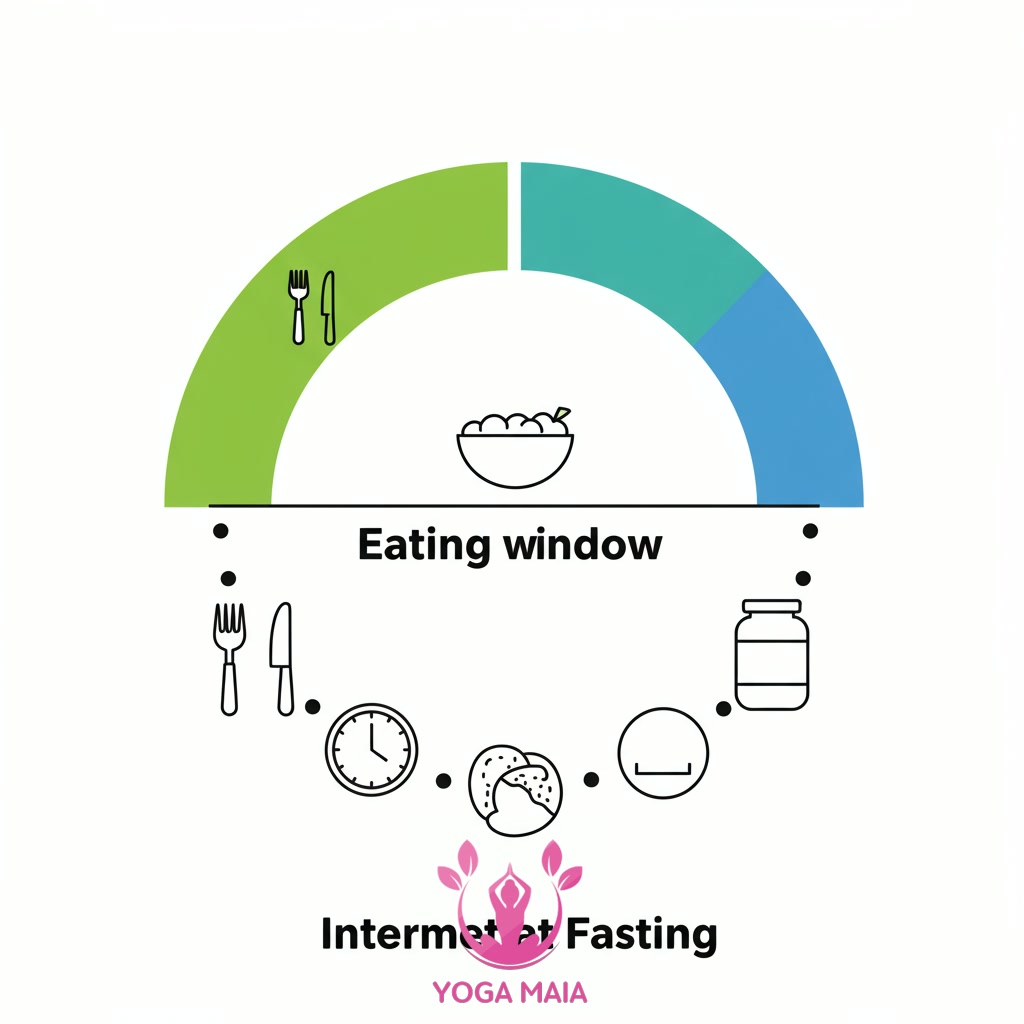Yoga Blog
Harmonizing Your Health: Integrating Intermittent Fasting with Yoga Practice

This content examines the synergistic relationship between intermittent fasting and yoga practice. It explores how integrating these two disciplines can contribute to enhanced health and overall well-being. The material outlines the potential benefits and provides guidance on practically combining fasting protocols with a regular yoga routine to achieve greater physical and mental harmony.
Table of Contents
- Section 1: Introduction: Exploring the Harmony of Fasting and Yoga
- Section 2: Understanding Intermittent Fasting: A Brief Overview
- Section 3: Understanding Yoga: Benefits for Mind, Body, and Spirit
- Section 4: The Synergistic Benefits: Why Combine IF and Yoga?
- Section 5: Practical Integration: Tips for Combining Your Practice
- Section 6: Finding Your Balance: Listening to Your Body
- Section 7: Conclusion: Embracing a Harmonized Approach to Wellness
Section 1: Introduction: Exploring the Harmony of Fasting and Yoga
Yoga has long been revered across cultures for its profound ability to cultivate physical strength, mental clarity, and spiritual balance. In parallel, intermittent fasting, a dietary approach focused on the timing of meals rather than strict calorie restriction, has gained significant attention in modern health discourse for its potential physiological benefits. While seemingly originating from different traditions and focusing on distinct aspects of well-being, these two disciplines share a core principle: mindful discipline leading to enhanced self-awareness and health. This document embarks on an exploration of the synergistic relationship between intermittent fasting and yoga practice. We aim to uncover how integrating these powerful tools can foster a deeper sense of harmony within the body and mind, paving the way for holistic well-being.
 Introduction: Exploring the Harmony of Fasting and Yoga
Introduction: Exploring the Harmony of Fasting and Yoga
Section 2: Understanding Intermittent Fasting: A Brief Overview
Yoga has long been revered across cultures for its profound ability to cultivate physical strength, mental clarity, and spiritual balance. In parallel, intermittent fasting, a dietary approach focused not on *what* to eat but *when* to eat, has gained significant traction for its potential health benefits. Understanding intermittent fasting is key to integrating it effectively. Unlike traditional diets that restrict calorie intake continuously, IF cycles between periods of voluntary fasting and non-fasting. Common methods include the 16/8 approach, where you fast for 16 hours and have an 8-hour eating window, or the 5:2 diet, involving two non-consecutive days of very low calorie intake per week. The core principle is to give the body extended periods without food, which can trigger various metabolic processes distinct from those occurring during constant digestion.
 Understanding Intermittent Fasting: A Brief Overview
Understanding Intermittent Fasting: A Brief Overview
Section 3: Understanding Yoga: Benefits for Mind, Body, and Spirit
Building on its long-standing reverence, yoga is a holistic practice that extends far beyond physical exercise, cultivating numerous benefits for the body, mind, and spirit. Physically, it enhances flexibility, builds strength, improves posture, and boosts cardiovascular health. Mentally, yoga is a powerful tool for stress reduction, promoting mindfulness, increasing focus, and calming the nervous system, leading to greater emotional resilience. On a deeper level, it fosters a connection between the mind and body, often leading to a sense of inner peace, self-awareness, and spiritual well-being. This integrated approach addresses the individual as a whole, paving the way for balanced health and vitality.
 Understanding Yoga: Benefits for Mind, Body, and Spirit
Understanding Yoga: Benefits for Mind, Body, and Spirit
Section 4: The Synergistic Benefits: Why Combine IF and Yoga?
Beyond the individual benefits of intermittent fasting and yoga, their combination unlocks a powerful synergy that elevates overall well-being. Intermittent fasting contributes to metabolic health, cellular repair through processes like autophagy, and often brings mental clarity during fasting windows. Yoga, on the other hand, cultivates physical strength, flexibility, balance, and profound mental calm through breathwork and meditation. When integrated, the metabolic resilience fostered by fasting can potentially enhance the body’s recovery and responsiveness to physical yoga practice. Simultaneously, the mindfulness and self-awareness developed through yoga can significantly support adherence to fasting protocols and a more intuitive relationship with food. This integrated approach fosters not just physical health but also mental fortitude and emotional balance, creating a harmonious internal state.
 The Synergistic Benefits: Why Combine IF and Yoga?
The Synergistic Benefits: Why Combine IF and Yoga?
Section 5: Practical Integration: Tips for Combining Your Practice
Successfully integrating intermittent fasting with your yoga practice requires mindful planning and listening to your body. Consider scheduling your yoga sessions during your fasting window, especially if you prefer lighter, more introspective practices like Hatha or Yin. For more vigorous styles such as Vinyasa or Ashtanga, practicing closer to your eating window might be beneficial for energy levels. Hydration is crucial; ensure you drink enough water throughout the day, particularly around your practice time. Pay close attention to how you feel – if you experience dizziness or fatigue, adjust your fasting schedule or the intensity of your yoga. Consistency in both disciplines, even with small adjustments, is key to unlocking their combined benefits and fostering greater physical and mental harmony.
 Practical Integration: Tips for Combining Your Practice
Practical Integration: Tips for Combining Your Practice
Section 6: Finding Your Balance: Listening to Your Body
Successfully integrating intermittent fasting with your yoga practice requires mindful planning and listening to your body. While scheduling sessions during your fasting window can be beneficial, it’s crucial to pay close attention to your body’s signals. Notice your energy levels, observe any sensations of dizziness or fatigue, and be honest about how you feel. Your body is your guide; if a particular pose feels too challenging or if you feel depleted, don’t push through. This might mean modifying your yoga practice on certain days or even adjusting your fasting schedule. Finding your unique balance is an ongoing process of observation, adjustment, and self-compassion, ensuring that both practices support, rather than hinder, your well-being journey.
 Finding Your Balance: Listening to Your Body
Finding Your Balance: Listening to Your Body
Section 7: Conclusion: Embracing a Harmonized Approach to Wellness
In conclusion, the integration of intermittent fasting with a regular yoga practice offers a profound pathway towards enhanced health and holistic well-being. As explored, success lies in mindful planning and, crucially, attentive listening to your body’s signals. This combined approach moves beyond mere physical discipline, cultivating a powerful synergy that supports metabolic health, mental clarity, and emotional equilibrium. Embracing this harmonized path empowers individuals to foster a deeper connection with their inner landscape, promoting resilience, vitality, and a sustained sense of balance. Ultimately, weaving these two practices together, with flexibility and self-awareness, can lead to a more vibrant and aligned life, embodying a truly integrated approach to wellness.
 Conclusion: Embracing a Harmonized Approach to Wellness
Conclusion: Embracing a Harmonized Approach to Wellness












